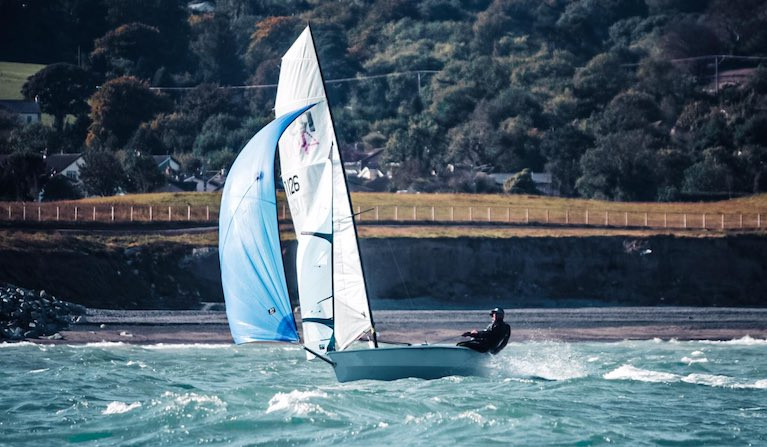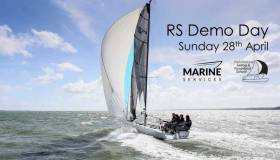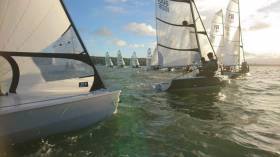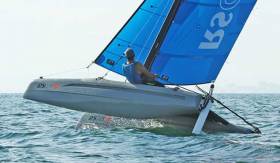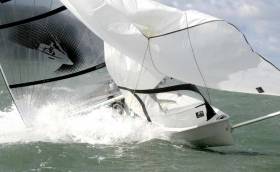Displaying items by tag: RS Sailing
Abandoned Final Race Rounds off Royal North RS 400 Winter Series on Belfast Lough
Just like on the previous Sunday the competitors in the final race day of Royal North of Ireland’s RS400 Winter Series hosted by the club on the south shore of Belfast Lough gathered last Sunday (19th) looking out at a mirror-like Lough. But this time it stayed like a mirror and the series came to a quiet end with the results for the previous week standing as the final results for the series.
It was close at the top after 19 races and the top prize went to Strangford Lough Yacht Club’s Peter Kennedy (former Olympian, All Ireland Champion Helm and Afloat Sailor of the Month for October 2018) and Stevie Kane of Royal North who finished with 44 points. The closest to Kennedy were two local boats, Andrew Vaughan and Toby McCullough on 54 points and Liam Donnelly and Rick McCaig, (56). The previous holders of the Bosun Bob’s Trophy, Trevor D'Arcy & Alan 'Ginge' McLearnon from across the Belfast Lough at Carrickfergus were fourth. Other visitors represented Coleraine YC, Newcastle YC, Ballyholme, and Newtownards. Another helm was two-time World Mirror champion, Ross Kearney.
This event has been running for about 14 years and built up from a handful of boats to the 20 entered this winter. The event always ends on the Sunday before Christmas.
The previous week bang on time for the Race 1 start a good southerly breeze materialised and thirteen crossed the line. For Race 2 and 3 wind direction was much the same and with the wind still building gains and losses were made on the downwind legs. Race Officer Gerry Reid, who has been running the series since its inception, made the most of those perfect conditions and slotted in one more race, repositioning the course in the increasing wind. Winners on that day were local crew Andrew Vaughan and Ross Nolan with Kennedy and Kane second in what was a very close set with only six points separating the top six boats.
Andrew Vaughan, the event director, thanked the support crews on Mark laying boats, the Committee boat and the Race Officer for series, Gerry Reid, Jack Anderson for the Results as well as the Office Staff.
Traditionally Royal North runs a Spring Series in the same format, and it is hoped that this will be possible in ’22 given the Covid 19 pandemic.
RS Sailing Launch RS Aero 6 Rig
Never one to leave a niche unfilled, RS Sailing have developed the RS Aero 6 rig to fill the gap between the existing 5 and 7 Rigs.
The new development is specifically designed for small adults, removing barriers for women and smaller men who have found themselves in between the previous options of rig sizes.
The new option provides major opportunities particularly for females in the sport.
The new rig system includes a 6.3m² mainsail, which is manufactured by North Sails.
As with all the RS Aero rig systems, a common top-mast and boom has been used, but the new bottom section has a unique stiffness and deck-level bend to ensure the RS Aero 6 rig is incredibly well-balanced.
 The new rig system includes a 6.3m² mainsail, which is manufactured by North Sails
The new rig system includes a 6.3m² mainsail, which is manufactured by North Sails
The radial cut sail is in line with the existing characteristics of the RS Aero 7 mainsail but with a slightly flatter head.
Working closely with an expert carbon fibre tube manufacturer with extensive testing, a new bottom mast section has been designed specific to the Aero 6. This is to ensure that the RS Aero 6 has the amazingly responsive feel that RS Aero owners are known to love.
"The new option provides major opportunities particularly for females in the sport"
With the class continuing to grow in Ireland and the current fleet thriving, it has accomplished 1st-4th top rankings in the DMYC Frostbites PY Class series 1” and with many more participating in the racing series, increasing options will only allow the fleet to grow further both at home and away.
The people buying RS Aeros range from multiple national champions, to people getting back into dinghies, to single-handed sailors looking for something different. While it remains competitive, the class is renowned for its welcoming and friendly approach.
With a busy 2022 Race Calendar, it will be interesting to see what the Aero 6 will do in its debut season.
For more information on anything Aero please don't hesitate to drop an email to [email protected] to organise a demo sail.
Aero 6 rigs will be available from Marine Services, the RS agent in early 2022
On the penultimate race day of the series, the RS400 crews gathered at the Royal North of Ireland Yacht Club with a mirror-like sea on Belfast Lough, that was not looking positive. The forecast was for the wind to be at least 10 knots and building all afternoon. In fact, Met Eireann had a yellow amber warning out for strong winds to the West of Ireland so it wasn’t a case of if, but when would the wind arrive. As someone had organised it, the wind appeared bang on time for the start of Race 1, we were able to take the bungs out of the bailers. The breeze was nice, a stable double-digit knot southerly and it was coming straight off the shore from Holywood.
Race 1 got underway with thirteen boats crossing the start line. The majority banged of to the left which seemed to pay off, I went off right and quickly realized, that was not the right way to go. Charles Kearney & Nick Thallon took a commanding lead at the windward mark closely followed by Andrew Vaughan & Ross Nolan and Trevor D’Arcy & Alan (Ginge) McLarnon all hot on their heels. Charles and Nick’s spinnaker leg didn’t go to plan as their wing wangs (Spigot) went wrong. 1188 sailed by Ryan Wilson and his crew who were in fifth, decided to go for a swim, this took them to the back of the fleet. At the end of race one, Trevor & Ginge took the bullet, followed by Andrew & Ross in second and Peter Kennedy & Stevie Kane in third.
Race 2 was very similar to race one, the wind stayed in the same position and the race started cleanly. Only twelve starters this time as Charles & Nick were busy trying to fix their wing wang. The wind was still building and it was the downwind legs where the gains and losses were being made. Nelson & Conway in 728 were up to sixth, but after a gybe which resulted in a swim, they threw in the towel, but they weren’t the only crews capsizing. Trevor & Ginge, the seasoned professionals also got into trouble, but somehow managed to shift their combined 200+kg onto the centreboard and pulled off a dry capsize and only dropped one spot! After two laps, Peter & Stevie took the bullet followed by Robert Hastings & Josh Porter in second and Andrew & Ross in Third.
Race 3, the wind was still building and for us, we were in the wrong spot at the start, we were pinned and were spat out the back of the fleet, yes dead last. Everyone went right this time, we had nothing to lose so sailed off the left and to our great pleasure the wind clocked to the left and low and behold, we tacked, we were in the better breeze and were bang on the windward mark and at the right end of fleet. The only crunching noise of the day happened at the second windward mark when Peter & Stevie came into the mark on port and didn’t see Robert & Josh on Starboard and boom! Luckily no damage and the industrial language was kept to a minimum. This put Pete & Stevie who were on for the third into sixth. After two laps, Andrew & Ross took the bullet, Liam Donnelly & Rick McCaig were second and Luke McIllwane & Hammy Baker into third which was impressive as they were seventh after round one.
As the conditions were perfect the race team kept us out for one more race. The rescue boats repositioned the course more to the left as the wind clocked and increased again. Eleven boats started and off they trucked to the windward mark. Frank McFarland & Gemma Vance in 500 had a nightmare as after going around the windward mark they anchored themselves to the wing mark and had to watch the fleet sail by. Trevor & Ginge lead from start to finish, Peter & Stevie leapfrogged numerous boats by getting a lucky gust on starboard and squeezed into second, pushing Luke & Hammy and Robert & Josh into third and fourth respectively.
Andrew Vaughan & Ross Nolan took the honours for the day with 11 points, Peter & Stevie were second on 12 points and Trevor and Ginge in third on 15 point. The racing on the day was so close there were only six points separating the top six boats.
As for the full series, it is also close at the top. After discards, Peter & Stevie are on 44 points, Andrew Vaughan is on 54 points and Liam and Rick are on 56 points.
Next Sunday the 19th December will be the last of the series. Racing will start at the earlier time of 12.30 and if the weather behaves itself, the race team hope to run four races which would fulfil the total amount of races for the series. Following the racing for the day, the crews will tucking into their Christmas Dinners followed by the prize-giving, which is always a good bit of craic. Any RS400s that have not taken part in the series but would like to join for the last day are very welcome.
The previous holders of the Frostie Series Trophy were D’Arcy & Ginge……will they still be the keepers of it after next weekend?
Espey & McCullough Win RS400 Northern Championships at Carrickfergus
The weekend of the 14th of August saw four fleets of RS classes, RS Feva, RS 200, RS Aero and the RS400, battle it out at Carrickfergus Sailing Club.
This is the first RS event Carrickfergus have run since the completion of their new slipway.
Robert Espey and Richard Mc Cullough were the overall winners of the RS400 Northern Championships, with a total of 24 boats competing in the class from all over Ireland.
Day 1, the weather was unpredictable with light winds and big wind shifts, however, Race Officer Robin Gray still managed to get 3 races away as he made best with the conditions. There were 3 different race winners on day 1 with race leads changing all the time, keeping things interesting.
The first race was won by Conor Galligan and Evan Smith of Greystones Sailing club, continuing on from their win at the last race at the Inlands.

The second race was won by Christopher Eames and Rachel Tilley of QMSC who had a solid event finishing second overall – they pushed Espey and McCullough all the way and finished just 2 points off the lead.
The third race of the day was won by Andrew Baker and Luke McIlwaine SLYC, with Baker coming in on good form after his recent win at the RS Aero Easterns.

Espey and McCullough managed to top the leader board at the end of day 1 with 3 second places.
Hospitality was provided by the club on Saturday evening and left everyone ready and eager for Sunday's racing.
Paul McLaughlin and Owen McKinley of CSBC took the lead in the first race on Sunday in heavier conditions.
Espey and McCullough took a 4th in this race but came back fighting and won the final 2 races – crowning them overall Champions of the event. Espey now has an impressive total of 4 wins at the Northern Championships.
The Irish Nationals is the next event, taking place at Rush Sailing Club in September. Going by the form of the fleet at the Northerns this is set to be a great battle.
Hoping to kick things off in late April at Greystones in County Wicklow, the RS Ireland dinghy class has set out its 2021 racing calendar.
The class has seen a resurgence of RS numbers in the garden county harbour, with the 400 fleet growing to 16 boats, the 200s to 12 and eight Fevas actively sailing through a reduced season in summer 2020.
Greystones Sailing Initiative
Greystones Sailing Club have put two new initiatives in place to further encourage the growth of the RS class, with one Saturday of each month being designated as an open day, meaning anyone can come along with their boat and join in the racing free of charge.
There are usually three races each Saturday with the first gun at 2pm. For those who are keen to do more and join the growing fleet, there is a discounted visitor rate for those who are already a member of another club.
 RS dinghy sailing in Greystones Bay, County Wicklow Photo: Scott Evans
RS dinghy sailing in Greystones Bay, County Wicklow Photo: Scott Evans
Irish RS Dinghy 2021 Fixtures
All dates below are obviously subject to the relevant COVID-19 guidelines in pace at the time of the events.
- Easterns - Greystones Sailing Club - Wicklow - April - 24/25
- Southerns - Baltimore Sailing Club - Cork- May 29/30
- Leinsters Dun Laoghaire Regatta - Dublin - July 2/3/4 - 200/400 Only
- RS Eurocup - Lake Garda, Italy - July 26-30
- Inlands - Blessington Sailing Club - Wicklow - July 24/25
- Northerns - Carrickfergus Sailing Club - Antrim - August 14/15
- Nationals - Rush - Dublin - September 10-12
The class is also targeting the Volvo Dun Laoghaire one design event, entry is now open. it falls nicely three weeks before a number of Irish boats are planning to decamp to Lake Garda for the 2021 RS Eurocup, planned for the end of July.
Irish RS agents, Irish National Marine Services, are really looking forward to showcasing the RS21 keelboat this coming weekend in Dun Laoghaire writes Kenny Rumball.
As the RS Eastern Championships are on in Greystones Sailing Club, this weekend, we are going to facilitate the current RS Sailors by sailing the RS21 to Greystones on Saturday while the Feva’s 200’s and 400’s are sailing, the boat will be available for test sails that afternoon from Greystones marina after sailing.
The RS21 will then return to Dun Laoghaire where our RS demo afternoon will be running from 1 pm onwards.
As well as the RS 21 we will also have a few of the RS Training Boats on the water too. The RS Zest and RS Quest are fantastic training boats and may be of interest to many clubs and training centres in the country.
An RS Aero will also be available for test sails.
For more information or to book your test sail, please contact [email protected] or 01284 4195
Espey & McCullough Lead Belfast Lough Frosty Series
Following Storm Etienne 21 crews arrived at Royal North for Day 6 of Belfast's Frosty Series, and were glad to see that there were no pieces of RS400 lying on the ground writes Sam Pickering. Even better, it was a warmish Sunday afternoon with a pleasant 10-12 knots blowing from the South West. A well-earned rest for crews who had been battered by several weeks of windy Sunday’s.
As ever, the race officer was keen to get back to the bar, so Race 1 began at 1.30pm sharp. A short line made it crucial to get a nice spot on the front row, and there were a couple that decided to stray too far and had to find their way back following an individual recall; one of these being Barry McCartin & Andrew Penney. Despite this they showed good pace upwind and were back in contention by the windward mark with Sam Pickering & Josh Porter managing to get around with a very small lead. Paul McLaughlin & Owen McKinley were also close by, just slightly ahead of the ever-present pack of boats waiting to swallow up and spit out anyone who dare make a mistake. There was little change the next time the fleet reached the windward mark, but a faltering breeze made the last run incredibly tricky. Sam was almost immediately swallowed by the pack after gybing too early, with Liam Donnelly suffering a similar fate. This left Barry & Paul to fight it out for the win. Barry eventually managed to clinch the victory. His win was almost as impressive as Rob Hastings recovering from a technical fault and a subsequent (very!) late start to recover to 6th place. Just imagine if he had been anywhere near the line! Bob Espey & Richard McCullough managed to fight off the rest of the bunch to round out the top three.
The second race saw somewhat of an anomaly for this series. A boat leading from start to finish. Although the highly desired committee boat end was won by Shaun Ritson, the inevitable jostling between boats slowed everyone near the packed out committee boat end. This allowed Tom Purdon & Rory Fekkes to shoot out from the middle of the line and go on to demonstrate good speed and astute fleet management to never look threatened in 1st place. This added another new race winner to the tally for the series, which now stands at eight. This time Chris Penney & Jess Rutherford managed to use good downwind speed to break free slightly to take 2nd place, with ‘Mr Consistent’ Barry taking 3rd spot. Ryan Wilson also put in a solid shift on the tiller, his best performance in Race 2, in order to demonstrate that crews can do it too.
The breeze built slightly towards the end of the second race, and after a tiny rest the crews started the 3rd race fully hiked out. Chris & Jess punched out from the line and rounded the top mark 1st, and with Jess completing all of Chris’ calm requests in a blink, they took off downwind in a nice gust. Sam & Josh had worked out which was the pointy end again and rounded 2nd, predictably followed by Barry & Andrew who were finding it hard to avoid being near the front. Peter Kennedy & Stephen Kane were on the prowl waiting to pounce. Unfortunately for them, the top three didn’t want to mess each other around, sailed their own races and kept up the speed to set up a three-way dual at the final leeward gate. Barry finally made a mistake by selecting the wrong side of the gate, which left Sam and Chris at the favoured right-hand mark. A slight overlap was enough to allow Sam to sneak round and go on to take the win, followed by Chris and then Barry.
As an Englishman who has recently moved to Northern Ireland to live and sail, the author would like to take this opportunity to thank the Irish 400 fleet for being so welcoming. I would also like to implore those back in Britain who are undecided about next years nationals to get off the fence and book your ferries now. You will not be disappointed! It is not very often you get to sail on such a fabulous stretch of water only 15 minutes from a capital city full of great activities for your support crew or you if your week starts going downhill. Of course, there will be Guinness to help with that too!
Kenny Rumball Promoting RS Boats at Paris Boat Show
Irish RS agent Kenny Rumball will be at the Paris Boat Show from the 8-16 December 2018 to showcase the RS Zest, RS CAT14 and RS21 as well as many French bestsellers like the RS Feva, RS Quest and the RS500.
RS CAT14
After the launch of the RS CAT14 at the Salon Nautique in Paris last year, the performance of this boat speaks for itself, says Kenny. The modern hull design results in a very well balanced, durable platform. Light on the helm, with smart structure, results in no breakages and high stiffness. The boat is reasonably light compared to other boats on the market making it hassle-free handling it on shore.
Sunday 4th November saw the first day of Belfast Lough's RS400 Frostie Series at Royal North of Ireland Yacht Club. Seventeen boats took to the water.
Download results below
The day started with nice a bright and really fresh breeze coming off the land at Holywood, but typically the wind started to calm down just before the first race, but there was enough to hike. The first race saw Ryan Seaton teamed with Tiffany Brien take the lead from the first mark and they managed to hold onto the lead until the end.
The second race was a bit more of a ding dong with Peter Kennedy and Stevie Kane leading the first round, closely pursued by Tom Purdon and Rory Fekkes, but by the next lap, Paul McLaughlin and Owen McKinley had overtaken both of them to take the win. The third race kicked off and the wind started to bend to the left. Luckily for veteran sailor Liam Donnelly and Skinny Rick it paid dividends and they lead from start to finish.
This Sunday 11th November, racing starts at 13.30. As a result of the tight racing and crowded mark roundings, it has been decided that there will be a spreader mark at the windward mark and the leeward mark will be gate marks. Numbers on the start line should be up with Bob Espey, Hammy Baker, Neil Cody, Ed Cody & Sam Pickering expected to join the fun.
Download results below
RS Sailors Heading for Baltimore Sailing Club
RS dinghy sailors are preparing for strong winds this weekend for the RS Southern Championships hosted by Baltimore Sailing Club.
So far there are over 40 boats entered - 17 x 400's 16 x 200's 8 x Fevas! which makes it one of the biggest regional events this year by numbers and chasing the Nationals hard! There are still more promised, meaning entries could be as many as 50 boats for the last major event of the season.


























